Serviços Personalizados
Artigo
Indicadores
Links relacionados
-
 Citado por Google
Citado por Google -
 Similares em Google
Similares em Google
Compartilhar
Education as Change
versão On-line ISSN 1947-9417
versão impressa ISSN 1682-3206
Educ. as change vol.26 no.1 Pretoria 2022
http://dx.doi.org/10.25159/1947-9417/8712
ARTICLE
Achieving Universal Digital Literacy through Universal Design for Learning in Open Educational Resources
Desirée Ayuso-del PuertoI; Prudencia Gutiérrez-EstebanII
IUniversity of Extremadura, Spain. deayusodelp@unex.es; https://orcid.org/0000-0002-6290-7391
IIUniversity of Extremadura, Spain. pruden@unex.es; https://orcid.org/0000-0001-5328-5319
ABSTRACT
Over the years, the Spanish education authorities have proposed various measures, such as the creation of Open Educational Resources (OERs), to guarantee the inclusion of all students in the education system. However, the literature on this topic indicates the persistence of certain challenges relating to the accessibility of OERs. In this regard, Universal Design for Learning (UDL) is presented as a possible solution to this problem as it advocates the personalisation of learning and facilitates the achievement of universal digital literacy. This study seeks to investigate the accessibility of OERs' design for those early stages in education that are managed by the Spanish education authorities. To this end, a guide of indicators has been designed to assess OERs in accordance with the principles of UDL. The sample is made up of 67 OERs, selectively based on a number of requirements. This study uses a quantitative and exploratory research methodology for the analysis of the data obtained. The main findings highlight the shortcomings of OERs in terms of accessibility, adaptability and universality, demonstrating that OERs do not respond to the principles of UDL.
Keywords: Open Educational Resources; Universal Design for Learning; universal digital literacy; inclusive education
Introduction
Inclusive education is generally defined as entailing the removal of barriers that prevent all learners, regardless of their personal characteristics, from accessing and participating in learning (De la Garza 2016; Pérez and González 2017). Accordingly, education authorities should propose flexible curricula that respond to the needs of learners and ensure that students are involved in their own learning (Berquist and Neapolitan 2019).
Universal Design for Learning (UDL) is presented as a flexible and innovative proposal since it advocates the creation of learning environments that do not require adaptation and are accessible to all students and teachers in general, thus promoting learning personalisation (Pilgrim and Ward 2017). UDL has an essential ally in information and communication technologies (ICTs) (Simón et al. 2016), which are presented within the teaching-learning process as an optimal way to achieve inclusive education and reduce the digital divide (Garcia Martinez, Aquino Zúniga, and Ramirez Montalvo 2016; Víquez 2014).
It was generally expected that world citizens would have achieved digital literacy by today, although the reality is that segments of the population are still adversely affected by inequalities in access to ICT (Nedungadi et al. 2018). Therefore, it is necessary to address the concept of "universal digital literacy", understood as the use and functionality of technology. This term considers, in a novel way, the personalisation of learning and student diversity with the aim of providing students the ability to transform the information they access into knowledge and, in this way, to be fully integrated into the digital society in which they live. Cummins, Adams Becker and Alexander (2016) assert that it also teaches collaborative skills and enhances critical thinking. Nevertheless, the concept of universal digital literacy has still not been adequately addressed in the field of educational research.
Open Educational Resources (OERs) are presented as a tool that can contribute to the reduction of social inequalities (Dinevski 2008). They are defined as all teaching materials that permit their adaptation and reuse, and they are fully and freely available to the educational community (Atenas and Havemann 2014; UNESCO 2015). These resources should be designed with an awareness that students are not a homogeneous entity-they have diverse needs and characteristics, and this needs to be taken into account in the design of OERs to ensure that everyone can use them (Avila 2018).
To this end, when planning or designing any course or virtual material, teachers must consider the principles of the UDL framework designed by the Center for Applied Special Technology (CAST 2011): it must provide multiple means of engagement, multiple means of representation, and multiple means of action and expression, based on the three brain sub-networks involved in learning, namely affective, recognition, and strategic networks (Alba Pastor, Sanchez Serrano, and Zubillaga del Rio 2014). The purpose of these principles is for the teacher to present the information through various means, to allow students to express what they have learned through different channels (orally, in writing, through images), and finally, to vary the means of learning according to the students' personal interests so that they feel committed to it.
The UDL also has to be incorporated into digital learning environments, as these spaces are not always designed to respond to student diversity (Fidalgo and Thormann 2017; Fitzpatrick, Mulwa, and Scepanovic 2017; Scott and Temple 2017). These digital learning environments can be more inclusive if they are in the public domain and use OERs, favouring accessibility and the dissemination and exchange of knowledge. In this regard, Pittman and Heiselt (2014) raise the need to create accessible materials for all students in the virtual courses, while Baldiris et al. (2017) point out that there are still some challenges in getting OERs to respond to student diversity, such as teacher training or the availability of creative tools. Likewise, OER repositories are not accessible because they fail to reach the minimum level of accessibility according to Web Content Accessibility Guidelines (WCAG 2.0) (World Wide Web Consortium [W3C] 2008), presenting important limitations such as a lack of content access via keyboard, a lack of textual alternatives to images and a lack of subtitles in videos (Bolanos Asenjo 2012; Da Rosa and Motz 2016; Monsalve, Medina, and Diaz 2018). Hence, there is a need for an in-depth assessment of the accessibility of OERs due to a lack of research about it.
Method
Sample and Procedure
This study uses a quantitative and exploratory methodology, with the aim of evaluating the Open Educational Resources hosted in Spanish repositories according to the principles of the UDL, with the aim of achieving universal digital literacy for all students.
To this end, 885 early childhood education, special education and primary education OERs, housed in the educational repositories Agrega2 (developed by the Spanish Ministry of Education, Culture and Sport) and Educarex and eScholarium (both managed by the government of Extremadura) have been selected for convenience. The sample selected for this study consists of 67 OERs because the rest of the resources did not meet the criteria mentioned below:
- The material should be designed for learners in the early childhood education or primary education age group.
- The material should be in Spanish.
- The material should be stored only in repositories managed by educational institutions at national and regional levels.
The following table lists the total resources that make up the sample and the repositories where these are hosted.
Table 1 shows that a total of 67 OERs hosted in three Spanish repositories were analysed based on the educational stages they address.

Instrument
Based on previous studies (CAST 2011, 2018; National Center on Accessible Educational Materials 2004; W3C 2018), an analysis indicator guide was specially built for this research for the purpose of data collection. This guide has been validated by a group of scholars with an extensive research career in educational technology and educational inclusion. The overall reliability index of the model obtained through the Kuder-Richardson Formula 20 (KR20) was .86, which shows a high level of reliability (García-Cadena 2006). The guide is available throughout the results section in the different tables presented. In the guide, the indicator will appear as collected if it has been considered within the resource (expressed in the results by "yes" in the evidence section). Conversely, if it has not been taken into account at the time of developing the resource, then it appears as "no" in the evidence section. To establish the level of accessibility of these resources, according to Duque et al. (2015), the percentage of the indicators considered for this evaluation was used as a basis (low: < 40% indicators, medium indicators: between 41%-79%, and high: > 80% indicators have been considered).
Results
The evaluation process was carried out according to the degree of presence of the 74 indicators used for the analysis of the OERs. All the results obtained have been organised according to the three dimensions and nine categories established in the guide of indicators, with the objective of identifying if these resources satisfy the educational needs of the students.

Following this structure, the results of the study are presented below.
Dimension 1: Provide Multiple Means of Representation

With regard to the first category, "Provide options for perception", all the resources lack options to adapt the information of the resource by modifying the text and the speed of synchronisation of the videos, sounds, or animations. These OERs also do not allow the conversion of non-textual content to other formats such as Braille or voice. However, 70.1% of the resources offer students the information through different sensory media.
The investigation has revealed that none of the resources offer alternatives for auditory information, such as sign language interpretation or written transcription of audio content. With respect to videos, only 43.3% of OERs include subtitles.
Regarding the visual information alternatives, 50.7% of the resources have no auditory keys. In addition, only 1.5% of the resources provide a voice description of the images.

Regarding the category "Provide options for language, mathematical expressions and symbols", the semantic elements through which the information is presented are accessible to Spanish students and linked to previous knowledge already acquired. However, at the same time, 98.5% of the OERs do not provide vocabulary in other languages and do not offer translation tools or links to multilingual glossaries. These concepts are not available in sign language either. Another point to consider is that 67.2% of the resources do not have a list of key terms that allow students to clearly identify the content. However, 83.6% include non-linguistic visual supports that clarify vocabulary.
With regard to the text, 56.7% of the resources have justified texts. However, some deficiencies are found, such as the lack of conceptual maps in 91.0% of the resources. On the other hand, in only 56.7% of the cases is the digital text accompanied by an audio with a pre-recorded human voice.
On a positive note, 85.1% of OERs offer students access to different types of problems.
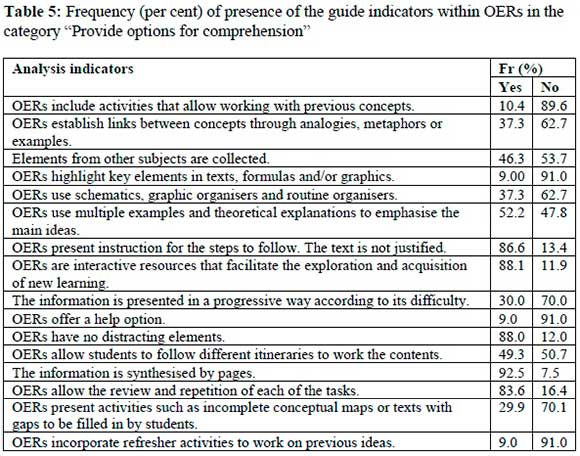
Lastly, concerning "Provide options for comprehension", 89.6% of the resources do not contain elements that activate students' previous knowledge, although 37.3% of the resources introduce examples allowing students to establish conceptual links. On the other hand, 91.0% of the resources coincide in not highlighting the basic elements or ideas in the text.
These resources guide the processing of information by incorporating instructions on the steps to be followed by students. In general, they present information in a fragmented way on different pages. Although they do not include help options (91.0%), 49.3% of these OERs allow students to work following different itineraries.
However, they do not present the information in a gradual way and consequently they do not foster the development of strategies in processing the information.
Dimension 2: Provide Multiple Means of Action and Expression

In the second dimension, "Provide multiple means of action and expression", 95.5% of the resources provide students with the option to answer questions using a mouse, but 72.7% did not offer a keyboard interface without requiring specific times for keystrokes.
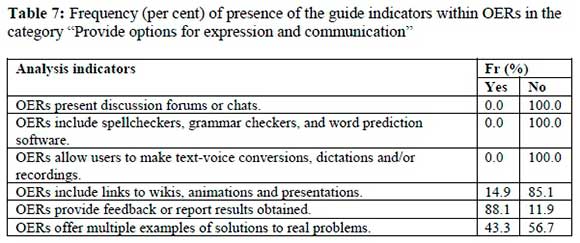
In the category "Provide options for expression and communication", a major shortcoming has been identified. None of the options offered allow students to participate and express themselves in discussion forums or chats with other peers. Furthermore, they do not offer grammatical proofreaders or word prediction software, and there are no text-to-voice conversions either.
On the other hand, 88.1% of the resources inform students of their results and in 43.3% of the cases they offer students multiple examples of solutions to real problems.
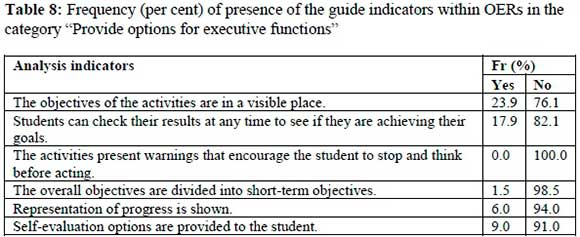
In the dimension "Provide options for executive functions", only 23.9% of the resources have visible objectives. Likewise, only 17.9% allow students to check their results at any time and therefore verify if they are achieving their goals. Similarly, in 94% of the available resources, students cannot observe their learning progress.
Dimension 3: Provide Multiple Means of Engagement
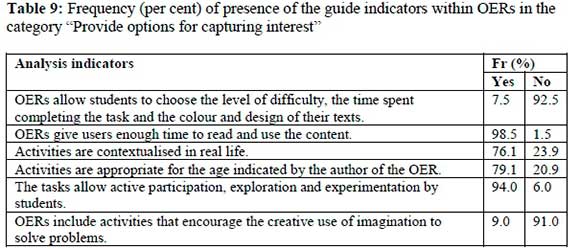
In reference to the third principle, "Provide multiple means of engagement", data analysis shows that 92.5% of the resources do not offer options that allow students to make use of their autonomy through decision-making tasks, such as choosing the level of difficulty or modifying the colour and the design of the results in text format. However, 98.5% of the resources provide the user with enough time to read and use their content.
On the other hand, these resources can be valuable to the student insofar as 76.1% of the resources are contextualised in real life. In addition, 94.0% of the resources offer tasks that encourage the active participation of students, allowing them to learn through tasks that encourage interaction and experimentation. Another important fact is that activities are age appropriate in 79.1% of the cases, except for some resources for early childhood education, which propose complex activities requiring writing to complete them. It is also worth noting that 91.0% of the resources do not include activities that encourage students to use their imagination to provide creative responses to problems that may arise.
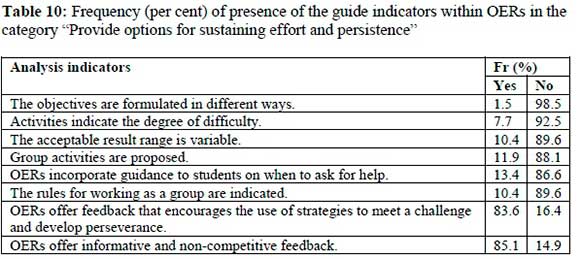
Although feedback is generally provided to students, there are obvious deficiencies in relation to the category "Provide options for sustaining effort and persistence". This is due to the fact that 98.5% of the resources do not present the objectives, thereby preventing students from consulting them.
Similarly, 92.5% of the cases do not indicate the degree of difficulty. Likewise, in 86.6% of the resources, they do not give any indication as to when or how to ask the teacher or their peers for help. Moreover, 88.1% of the resources lacked activities that encourage collaboration and teamwork.
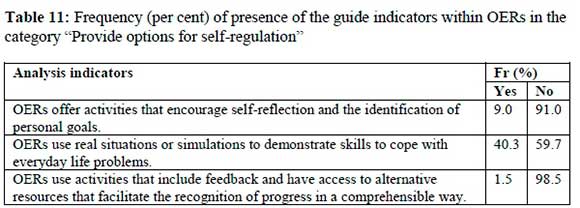
Regarding the last dimension, "Provide options for self-regulation", 91.0% of the resources do not include activities that encourage self-regulation and self-reflection by students, and they are not given access to their progress.
Finally, only 40% of OERs use real situations or simulations to demonstrate the necessary skills to cope with everyday problems.
Discussion and Conclusions
In the past decade, the role of educational technologies in inclusive education has increasingly gained prominence, both for the possibilities and potential benefits they offer. Thus, the principles of UDL become more crucial than ever, as they could reduce the barriers that prevent students from satisfactorily achieving their academic development and being competent and fully integrated citizens in the digital society in which they live.
It is important to remember that digital literacy plays a very important role in educational inclusion. The entire educational community must work on digital literacy from a holistic perspective by taking advantage of the potential of digital technologies with regard to the personalisation of training and learning itineraries in order to ensure universal and accessible learning design. This, in turn, fosters a new concept of "universal digital literacy".
Several authors (Dinevski 2008; Muller 2021; Ramoutar 2021) concur that OERs have the potential to address the educational challenges posed by the diversity of student learning. However, this means they must be evaluated in order to ensure that they are accessible to all students.
Based on the above, this research is presented as a quantitative and exploratory study in which 67 OERs hosted in Spanish repositories (Agrega2, Educarex and eScholarium) have been analysed. For their evaluation, a guide of indicators has been designed according to the principles of UDL, aimed at achieving universal digital literacy.
With regard to the objective of this study, it can be seen that some barriers for users with impaired vision are not taken into account, as the resources do not offer options that allow the adaptation of information. These results match those outlined by Da Rosa and Motz (2016) in their study. Consequently, OERs do not guarantee that students with difficulties in accessing and understanding information will have access to it. In addition, in accordance with Monsalve, Medina and Diaz (2018), it is important to point out that the images included are not accompanied by their description in voice or text format, an aspect which makes it difficult for students with visual impairment or those who have not acquired reading skills yet (due to their age) to access the information contained in visual representations.
These OERs also lack options for answering questions with a keyboard interface without requiring specific times for keystrokes, an aspect that presents barriers for those who have motor impairments. Moreover, OERs do not offer equal opportunities in the participation of the learning process, as the navigation and interaction required by the activities are not accessible to all students.
Regarding the stage of early childhood education, only half of the OERs include digital texts accompanied by an audio with a pre-recorded human voice. This is a requirement that could be considered fundamental at this educational stage, since students are not yet familiar with the symbols and could have difficulties in decoding the text. As a result, the lack of hearing support will reduce their ability to process and assimilate information. In addition, they do not offer grammatical proofreaders or word prediction software that could help students to write or allow text-to-voice conversions. Moreover, these OERs do not offer options that allow students to express themselves through other means either.
Thus, students are not offered the support (scaffolding) that allows them to gradually learn how to set their own realistic personal goals and develop strategies to achieve them. This is a problem for students with deficits in executive function or those who are still immature and set unrealistic goals. At this age, learning is based on the scaffolding theory, so the necessary supports must be provided gradually and withdrawn later (Elbers, Rojas-Drummond, and Van de Pol 2013; Veraksa et al. 2016). This could help the learner to identify and learn how to manage responses to external stimuli, as well as to identify negative thoughts or events that may cause anxiety.
At the same time, in accordance with the principles of the UDL established by CAST (2011), the OERs would make it harder for non-native students to understand the vocabulary because it is not available in other languages. In this regard, the OERs do not present lists of key terms, which hinders the access to information for immigrant students. In addition, these concepts are not available in sign language either, which is an obvious obstacle for deaf students. In fact, we noted that none of the resources provides sign language interpretation of the audio content. Therefore, some students cannot access these audio files.
Moreover, the resources do not include activities that encourage self-regulation and self-reflection by students. This is compounded by the students' lack of access to their progress, a situation that can lead to frustration and anxiety about not achieving the established objectives. It should also be recalled that most cases do not indicate the degree of difficulty. This is a negative factor since students are not offered the option of finding challenges that could increase their motivation and enable them to work harder to achieve their goals. These resources do not encourage the learners to have positive thoughts or to feel confident about their ability to achieve these goals. This could possibly decrease student motivation and detrimentally affect their control over their emotions.
A similar situation can be found in the planning and development of strategies, due to the absence of notifications that encourage students to stop and think before acting. This hampers students' competence in planning the steps that are required for achieving their objectives, something which would be essential when working with young students who may also present mismatches in executive functions.
These resources are not conducive to the transfer and generalisation of learning to new situations because they do not employ techniques to increase the likelihood of remembering information or encourage students to use certain strategies. This fact is reflected in the absence of activities such as incomplete conceptual maps or gapped texts that students have to complete, which makes it difficult to establish links between new information and the background knowledge they already have. In addition, key content is not highlighted in the texts and therefore students are not provided with help to distinguish between relevant and irrelevant information. This problem had also been previously detected by Monsalve, Medina and Diaz (2018) in their analysis of OERs hosted in Colombia Aprende repository.
Conversely, at least half of the resources incorporate multiple examples to emphasise the main ideas. Furthermore, these resources present information in a fragmented way on different pages, favouring exploration and interaction by students. Likewise, these interactive resources promote the exploration and construction of new learning. These resources can also be valuable to the students, given that most are contextualised in real life situations, which captures their interest because the information is relevant to them.
In general, the feedback provided by the resources helps maintain students who are motivated and interested in learning. Likewise, it encourages them to try again when faced with mistakes, fostering perseverance and effort. These factors favour the construction of an adjusted and positive self-concept.
In conclusion, OERs do not meet the needs of all users because they do not consider several of the indicators contained in the guide designed for their evaluation. Hence, none of them has been classified with a high accessibility level. These findings are consistent with those of studies by other authors such as Monsalve, Medina and Diaz (2018), Da Rosa and Motz (2016) and Bolanos Asenjo (2012).
Overall, more research would be required to identify the level of accessibility of resources at other educational levels such as primary and compulsory secondary education. In addition, further studies should focus on their adaptability, versatility, and customisation possibilities to achieve learning, according to the educational characteristics and needs of every student, both for online and in-person learning environments. These studies could incorporate the analysis of the accessibility of each repository by using automatic evaluation tools.
On the other hand, the analysis of accessibility could be extended to other virtual learning environments to which young people have access, taking into account the principles of UDL.
Finally, it would be interesting to conduct a series of in-depth interviews with special education teachers, along with hearing and language teachers, to enquire about their views on the accessibility of OERs, and to explore their knowledge, opinions, and experience of these resources in responding to the educational needs of students.
Acknowledgement
The study is funded by the Spanish Ministry of Science, Innovation and Universities via a pre-doctoral contract for University Teacher Training to the first author (FPU18/03322). The project was co-financed by the European Regional Development Fund (FEDER) and Junta de Extremadura.
References
Alba Pastor, C., J. M. Sánchez Serrano, and A. Zubillaga del Río. 2014. Diseno Universal para el Aprendizaje (DUA) Pautaspara su introducción en el currículo [Universal Design for Learning (UDL): Guidelines for Its Introduction in the Curriculum]. Madrid: EducaDUA. Accessed November 19, 2020. https://www.educadua.es/doc/dua/dua_pautas_intro_cv.pdf. [ Links ]
Atenas, J., and L. Havemann. 2014. "Questions of Quality in Repositories of Open Educational Resources: A Literature Review". Research in Learning Technology 22 (1): 1-13. https://doi.org/10.3402/rlt.v22.20889. [ Links ]
Avila, C. 2018. "Tracing the Creation and Evaluation of Accessible Open Educational Resources through Learning Analytics". PhD diss., University of Girona. Accessed November 19, 2020. https://dugi-doc.udg.edu/bitstream/handle/10256/15837/tcag_20180612_2.pdf?sequence=1&isAllowed=y. [ Links ]
Baldiris, S., L. Mancera, G. L. V. Saldarriaga, and J. Treviranus. 2017. "Co-evaluation, to Scaffold the Creation of Open Educational Resources". In Advances in Web -Based Learning-ICWL 2017, edited by H. Xie, E. Popescu, G. Hancke and B. Fernández Manjón, 168-76. Cham: Springer. https://doi.org/10.1007/978-3-319-66733-1_18.
Berquist, L., and J. Neapolitan. 2019. "Using Professional Learning Communities to Redesign Learning Environments in Heis". In Transforming Higher Education through Universal Design for Leaning: An International Perspective, edited by S. Bracken and K. Novak, 101-11. London: Routledge. https://doi.org/10.4324/9781351132077-7.
Bolanos Asenjo, M. A. 2012. "La accesibilidad web en los repositorios institucionales: la UOC a examen" [Web Accessibility in Institutional Repositories: The UOC under Review]. PhD diss., Open University of Catalonia. Accessed November 19, 2020. http://openaccess.uoc.edu/webapps/o2/bitstream/10609/12043/1/mbolanosa_TFC_0112.pdf. [ Links ]
CAST (Center for Applied Special Technology). 2011. Universal Design for Learning Guidelines Version 2.0. Wakefield: CAST. Accessed November 19, 2020. http://udlguidelines.cast.org/more/downloads. [ Links ]
CAST (Center for Applied Special Technology). 2018. Universal Design for Learning Guidelines Version 2.2. Wakefield: CAST. Accessed November 19, 2020. http://udlguidelines.cast.org/binaries/content/assets/udlguidelines/udlg-v2-2/pauta-dua_v2-2_espanol.pdf. [ Links ]
Cummins, M., S. Adams Becker, and B. Alexander. 2016. NMC Horizon Project Strategic Brief on Digital Literacy. Volume 3.3. Austin, TX: The New Media Consortium. Accessed November 19, 2020. https://www.learntechlib.org/p/173858/. [ Links ]
Da Rosa, S., and R. Motz. 2016. "^Tenemos repositorios de REAs accesibles?" [Do We Have Accessible OERs Repositories?]. In Simposio Internacional de Informática Educativa, edited by F. J. Garcia- Penalvo and A. J. Mendes, 473-78. Salamanca: Editions of University of Salamanca. Accessed November 19, 2020. https://gredos.usal.es/handle/10366/131593.
De la Garza, I. I. 2016. "Personalización de la ensenanza desde el Diseno Universal para el Aprendizaje" [Differentiated Teaching from the Universal Design for Learning]. Revista nacional e internacional de educación inclusiva 9 (2): 170-182. Accessed November 19, 2020. https://revistaeducacioninclusiva.es/index.php/REI/article/view/58/53. [ Links ]
Dinevski, D. 2008. "Open Educational Resources and Lifelong Learning". In Proceedings of the ITI2008-30th International Conference on Information Technology Interfaces, edited by V. Luzar-Stiffler, H. Dobric and Z. Bekic, 117-122. Dubrovnik: Institute of Electrical and Electronics Engineers. https://doi.org/10.1109/ITI.2008.4588393.
Duque, N., A. Ospina, L. F. Londono, and V. Tabares. 2015. "Evaluation of Accessibility of Multimedia Digital Educational Resources". Revista Ingeniería e Innovación 3 (1): 90-97. https://doi.org/10.21897/23460466.793. [ Links ]
Elbers, E., S. Rojas-Drummond, and J. Van de Pol. 2013. "Conceptualising and Grounding Scaffolding in Complex Educational Contexts". Learning, Culture and Social Interaction 2 (1): 1-2. https://doi.org/10.1016/j.lcsi.2012.12.002. [ Links ]
Fidalgo, P., and J. Thormann. 2017. "Reaching Students in Online Courses Using Alternative Formats". The International Review of Research in Open and Distributed Learning 18 (2): 139-61. https://doi.org/10.19173/irrodl.v18i2.2601. [ Links ]
Fitzpatrick, D., C. Mulwa, and S. Scepanovic. 2017. "EAGLE: An Accessible Platform for Delivery of Learning Materials". The Journal on Technology and Persons with Disabilities 238-51. Accessed November 19, 2020. http://scholarworks.csun.edu/bitstream/handle/10211.3/190215/JTPD-2017-p238-251.pdf?sequence=1. [ Links ]
Garcia-Cadena, H. 2006. "Measurement in Social Sciences and Psychology". In Statistics with SPSS and Research Methodology, edited by R. Landeros and M. Gonzalez, 139-66. Mexico City: Trillas.
Garcia Martinez, V., S. P. Aquino Zúniga, and N.A. Ramirez Montalvo. 2016. "Programa de alfabetización digital en México: 1:1. Análisis comparativo de las competencias digitales entre ninos de primaria" [Digital Literacy Programme in Mexico: 1:1. Comparative Analysis of Digital Skills among Primary School Children]. Revista de Investigation Educativa 23: 24-44. https://doi.org/10.25009/cpue.v0i23.2158. [ Links ]
Monsalve, C. L., C. Medina, and W. Diaz. 2018. "Recomendaciones para la construcción de Recursos Educativos Abiertos inclusivos y accesibles" [Recommendations for Building Inclusive and Accessible Open Educational Resources]. PhD diss., University of Antioquia. http://hdl.handle.net/10495/11661. [ Links ]
Muller, F. 2021. "On the Road to Inclusive Education: Supporting Diversity in Education by State-Financed, Large-Scale OER Platforms-The Example of User-Oriented Development of NDLA in Norway". Education Research International 1-11. https://doi.org/10.1155/2021/5534641. [ Links ]
National Center on Accessible Educational Materials. 2004. National Instructional Materials Accessibility Standard Report-Version 1.0. Wakefield: National Center on Accessible Educational Materials. Accessed November 19, 2020. http://aem.cast.org/about/publications/2004/ncac-nimas-report-national-file-format.html. [ Links ]
Nedungadi, P. P., R. Menon, G. Gutjahr, L. Erickson, and R. Raman. 2018. "Towards an Inclusive Digital Literacy Framework for Digital India". Education + Training 60 (6): 516-28. https://doi.org/10.1108/ET-03-2018-0061. [ Links ]
Pérez, C. V., and O. H. Gonzalez. 2017. "El Diseno Universal para el Aprendizaje, una alternativa para la inclusion educativa en Chile" [Universal Design for Learning, an Alternative for Educational Inclusion in Chile]. Atenas 4 (40): 105-20. Accessed November 19, 2020. https://www.redalyc.org/articulo.oa?id=478055150008. [ Links ]
Pilgrim, J. L., and A. K. Ward. 2017. "Addressing Diversity through the Universal Design for Learning Lens". In Addressing Diversity in Literacy Instruction, edited by E. Ortlieb and E. H. Cheek, 229-49. Bingley: Emerald Publishing. https://doi.org/10.1108/S2048-045820170000008011.
Pittman, C. N., and A. K. Heiselt. 2014. "Increasing Accessibility: Using Universal Design Principles to Address Disability Impairments in the Online Learning Environment". Online Journal of Distance Learning Administration 17 (3): 1 -11. Accessed November 19, 2020. https://eric.ed.gov/?id=EJ1044112. [ Links ]
Ramoutar, S. 2021. "Open Education Resources: Supporting Diversity and Sharing in Education". TechTrends 65: 410-12. https://doi.org/10.1007/s11528-021-00615-7. [ Links ]
Scott, L., and P. Temple. 2017. "A Conceptual Framework for Building UDL in a Special Education Distance Education Course". Journal of Educators Online 14 (1): 48-59. Accessed November 19, 2020. https://eric.ed.gov/?id=EJ1133749. [ Links ]
Simón, C., G. Echeita, M. Sandoval, A. Moreno, C. Márquez, M. L. Fernandez, and E. Pérez. 2016. "De las adaptaciones curriculares al diseno universal para el aprendizaje y la instrucción: un cambio de perspectiva" [From Curricular Adaptations to Universal Design for Learning and Instruction: A Change of Perspective]. Paper presented at the Congreso accesibilidad, ajustes y apoyos, Madrid, Spain, May 24-25, 2016.
UNESCO (United Nations Educational, Scientific and Cultural Organization). 2015. Guidelines for Open Educational Resources (OER) in Higher Education. Paris: UNESCO. Accessed November 19, 2020. https://unesdoc.unesco.org/ark:/48223/pf0000232855. [ Links ]
Veraksa, N., O. Shiyan, I. Shiyan, N. Pramling, and I. Pramling-Samuelsson. 2016. "Communication between Teacher and Child in Early Child Education: Vygotskian Theory and Educational Practice". Journal for the Study of Education and Development 39 (2): 221-43. https://doi.org/10.1080/02103702.2015.1133091. [ Links ]
Viquez, I. G. 2014. "ICTs in Inclusive Education and Influence in Preschool Learning". Paper presented at the Congreso Iberoamericano de Ciencia, Tecnologia, Innovación y Educación, Buenos Aires, Argentina, November 12-14, 2014.
W3C (World Wide Web Consortium). 2008. Web Content Accessibility Guidelines (WCAG) 2.0. Cambridge, MA: W3C. Accessed January 20, 2022. https://www.w3.org/TR/2008/REC-WCAG20-20081211/. [ Links ]
W3C (World Wide Web Consortium). 2018. Web Content Accessibility Guidelines (WCAG) 2.1. Cambridge, MA: W3C. Accessed November 19, 2020. https://www.w3.org/TR/WCAG21/. [ Links ]














